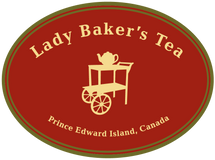A Different Kind of Tea Party
As a recently certified Tea Sommelier, I wondered just what might present itself to give me an opportunity to 'strut my stuff!' And then a knock came at my door.
An acquaintance, Mary, asked if I would do a tea presentation to her fundraising group, the WoHeLo (Work, Help, Love) ladies of the Queen Elizabeth Hospital. They're a great group of humble, hard-working women dedicated to raising money for hospital equipment through their special activities.

At this request, I rose to the occasion and invited them to the Abbey for an hour of exploring teas throughout the world by tasting 5 of the 6 types of tea. White, Green, Oolong, Black and Puerh. Yellow tea is the 6th rare type and I did not provide it for the party.
With little cups in hand, I poured White Silver Needle and White Pai Mutan for them to sip and compare. In Lady Baker's (LB's) stock, we have the Pai Mutan which we also call White Peony. The Silver Needle is the unopened bud which is quite downy. The White Peony is both the bud and the leaf below the bud.
Comments: "Ooh, sweet!" "A bit like honey."
Questions: When's a good time of day to drink this?
Answer: Because of its light and delicate taste, I would suggest in the afternoon. But as I have learned, whatever one likes, whenever one likes it, is the best time!
We moved on to green tea, the Japan Sencha which is steamed to stop oxidation and China Gunpowder (LB's Green Explosion) which is roasted to stop oxidation. The top two leaves and a bud are plucked for these teas.

Comments: "I don't like green tea." (Gunpowder)... "That's better. It's not so bitter." (Sencha)... "Grassy, like seaweed." (Sencha). I explained I may have brewed the Gunpowder a bit too long, thus the bitterness, but I did not pick up on the bitterness myself, just the smokiness. Bitter is a word I hear often in relation to green tea. Brewing it at 80C is ideal and not longer than 3 minutes. This will make all the difference when using specialty loose leaf green teas.
Questions: Why 2 leaves? Why not all the leaves?"
Answer: The leaves downward on the stalk are larger and tougher, so they are not considered as valuable.
We continued round the table to the short oxidized oolong (Lady Baker's Oo-la-long) and the long oxidized (our Bamboolong).
Comments: "Ahh, so floral!" (short oxidized)..."Is this tea?" (long oxidized)
We could have gone on at length about the oxidation process especially with oolongs. It's one of those mind-boggling things that a tea master can nose the tea to determine if it is time to stop the oxidation for the particular oolong that is being produced that day.

Our next tasting was more familiar to the ladies. Black tea is fully oxidized and yet has so many different flavours! I prepared a Keemun (China) my go-to breakfast tea and an Assam (India) my second go-to breakfast tea.
Comments: "Definitely a bit smoky," "not sure about fruity," (Keemun)..."Yup, this is more like it, like King Cole" (Assam)..."This is so interesting. I just thought of tea as generic."
Questions: What about caffeine? Is it the least in white tea and then green tea?
Answer: The best we can do about caffeine content in tea is to say that per cup there's anywhere from 25-34 mg of caffeine and that means about 1/3 of the amount that is in a cup of coffee. Generally we think of white tea and green tea having the least amount of caffeine, but there are many factors that can make that assumption untrue.

Last but not least was the Puerh, pronounced poo-air. As a fermented and aged tea of China, I expected the response to be less favourable. It is a tea that I, myself, have not found to my liking. It's earthy and musky and a term that works for me, barnyardy! We sampled a plain Puerh but in LB's stock we have only the Scottish Caramel Puerh which makes one of our most popular lattes.
Comments: "That's not too bad." "It's not as strong as I thought it would be." "It's definitely different." "I like this."
Throughout our tasting, there were screwed up noses and some dumping of tea from the cup into a bowl for those who just did not fancy their first sip! But overall, there was intrigue and fascination! We had fun and the subject of tea created a buzz in the room that was truly satisfying. There's so much to tea!
I say a big thank you to the WoHeLo group. They inspired me with their genuine interest and allowed me to use them as guinea pigs on my journey of giving tea workshops. I look forward to many more such occasions. If you, reader, would like to have such a tea tasting, please don't hesitate to be in touch.

Leave a comment
Please note, comments must be approved before they are published